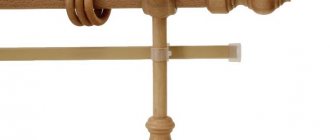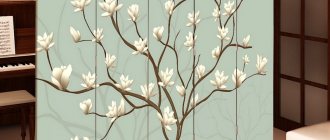Selecting a model taking into account room parameters
They begin work by choosing a model based on the characteristics of the kitchen space. The total area, size and shape of the window, and overall design are taken into account. In one case, hand-sewn short curtains for the kitchen look better; in another, you should give preference to long curtains.
The following measurements are made:
- Total ceiling height.
- Distance from the ceiling to the window sill (this parameter is especially important if the curtains are short).
- The distance between the ceiling and the curtain or cornice.
In addition to the main parameters, additional ones may be needed, for example, the size of the window sill overhang or the width of the walls. This is especially important if the window and the wall next to it have complex geometry.
Important! When designing curtains from thin fabrics (tulle or organza), it is important to correctly determine the size of the battery and its position relative to the window, otherwise the material will deteriorate from contact with heated metal.
The aesthetic side is of great importance. There are five popular styles of curtains:
- Austrian - ruffles and lambrequins.
- The French style is distinguished by heavy folds.
- The Roman style assumes strict and laconic contours.
- Rustic style (country, Provence, etc.) prefers modest decorations and ties for fastening.
- A special type is curtains with hinges.
Designers have developed combined models that combine features of different types. In addition to stylistic decisions, curtain sewing experts recommend adhering to the following recommendations:
- If the windows are small, then the abundance of frills, lambrequins, ruffles, folds and other decorative elements will “overload” the interior. It is better to stick to a laconic cut.
- For kitchens facing the south and east side of the house, the ideal solution would be a combination of translucent tulle with thick curtains. This way you can create the ideal level of illumination in any weather.
- If the windows face north or are shaded by trees, the room will be gloomy most of the year, and curtains made of dark dense material will only enhance this impression. It is better to get by with curtains made of translucent chintz fabrics in light shades: white, beige, pastel colors.
Whatever fabric you choose, it must have a sufficient fire safety rating. Remember that there is always a risk of fire in the kitchen. Typically, curtains are made from materials impregnated with special solutions that protect them from flames.
We fit curtains into the interior
Each style of interior design has its own canons of window decoration. For example, the classics are characterized by a combination of translucent tulle fabric with thick curtains, a lambrequin and tiebacks. This model looks good on a large window.
For modern style, a compact Roman blind is well suited. High-tech involves the use of blinds, but curtains are also acceptable - smooth, straight, made of blackout fabric. In the oriental style, curtains are used with a print in the form of bamboo stems or sakura branches during the flowering period.
Patchwork curtains
An interesting solution for a country-style kitchen is sewing using the patchwork technique. A couple of hundred years ago, when textile production was just developing and the material was very expensive, our ancestors treated every rag with care and made prefabricated blankets, curtains and rugs. It was then that the patchwork technique was born. Today it is a special chic, since it is no longer performed in order to save money, but allows the master to show his imagination.
The main rule for selecting patches for such a curtain is their uniform texture and colors that are in harmony with each other (and with the kitchen design). To keep the work simple, cut the fragments into identical shapes: rectangle or square. The larger the fragments, the easier it is to work. To make the curtain look stylish, come up with a patchwork mosaic and assemble the canvas according to the pattern. Cover the finished curtain with braid or crochet it.
It will also be interesting: Photos and videos of making Roman blinds from blinds with your own hands
There is nothing difficult in creating a curtain with your own hands if you have the skills to work with fabric, needle and thread. Use your imagination, do the work with love, and you will definitely end up with a unique product that will add warmth and comfort to your kitchen.
Save
Calculation of the amount of fabric
The exact amount of fabric needed for sewing depends on how to sew curtains for the kitchen. First of all, determine the length of the required piece of fabric. For a long model, take the distance from the floor to the cornice and add 0.25 m to it for hems at the top and bottom. For a short model, proceed in the same way, only the distance from the eaves to the window sill becomes the basis.
The width of the cut is taken from the distance between the edges of the window (the whole for single models, half for double ones). This value is multiplied by a coefficient determined by the curtain model (the type of fold and the method of attaching the curtain to the curtain or cornice matter):
- model with hinges – 1.5 or 2;
- model on curtain tape – 2;
- with eyelets – 2;
- curtain with triple folds – 2;
- The most expensive options in terms of material are puffs and pencil folds, for which a coefficient of 2.5 is taken.
The resulting value is increased by 0.4 m for hems on both sides.
Advice! Before you start sewing, wet the material and dry thoroughly. If the fabric tends to shrink, it is better to find out about it right away than to find out that the curtains have become smaller only after the first wash.
Let's illustrate how to use these instructions with examples. Let's say you plan to sew long curtains. Let the height from the floor to the cornice be 2.1 m. The length of the working part of the curtain is 1.8 m.
Tulle
The tulle is hung in one panel. Eyelets were chosen as folds. Cut length: 2.1 m + 0.25 m = 2.35 m (2 m 35 cm). Width – (1.8 m x 2) + 0.4 m = 4 m.
Curtains
Let's say the curtains will have triple folds. They require two panels. The length is calculated in the same way as for tulle and will be 2.35 m. The width is calculated as follows: (1.8 m x 2) = 3.6 m. We divide this panel in two, add 0.4 m to each piece. We get two panels with a length of 2.35 m and a width of 2.2 m each.
Tips for needlewomen
A variety of patterns for kitchen curtains allow women to experiment. Any preparation can always be diversified using:
- unusual decor;
- original material;
- stylish extraordinary edging of the canvas.
Curtains for the kitchen
It is also important to consider that sewing curtain fabric yourself requires knowledge of at least the basics of this type of needlework. If a craftswoman has just begun to master the skills of such work, she is recommended to watch several videos in the spirit of “sew myself,” understand master classes and learn to “read” patterns.
Before you start working on creating curtains, you need to decide on the product design and material. To sew an accessory with your own hands, it is recommended to start with a sketch. To do this, you can use ready-made photos and ideas. It is possible to sew curtains for the kitchen from a pattern without outside help. The main thing is to keep a sample in front of your eyes for clarity.
Preparation of the workplace
Sewing kitchen curtains with your own hands will become much easier if everything you need is prepared for the job in advance. You should have at hand:
- A piece of chalk for marking fabric.
- Tailor's tape.
- Scissors.
- Pins to be able to secure the material.
- Sewing threads.
The main difficulty in working with curtains is the large size of the fabric. It can be difficult to place them on the cutting table. Often the only fairly level place is the floor.
When sewing, proper organization of your workspace is also important. The machine must be stable, not sway, and the work area must be well lit. It is better if there is a table lamp with a flexible leg. The line is drawn away from you while working. The ironing board is placed close to the machine so that you can immediately iron the seams.
Choosing a style and material for curtains
Depending on the design of your kitchen, you need to choose curtains. They can be made in the following styles:
- classical;
- Oriental;
- country;
- minimalism.
Choosing the right style is very important not only from an aesthetic point of view, but also from a practical one. For example, if your task is to visually enlarge a small kitchen, velvet and heavy curtains are unlikely to help you with this, which means that the classic style is not suitable in this case.
Even before choosing fabric, you need to decide on the style. It is no secret that the composition and production technology of fabric affect its drapery, light transmission and appearance. In order to emphasize the beauty and comfort of the kitchen, choose natural materials, but be careful with silk: it changes shades depending on the lighting, and this effect can be detrimental to the design.
Determine the main practical function of the curtains: whether it will be protection from excess sunlight or retaining heat in the cold season, whether you want to visually enlarge the kitchen with them or hide unsuccessful risers and pipes - the choice of fabric will depend on the purpose of the finished product.
Next, think about the color scheme. It is ideal when all kitchen textiles are of the same color scheme, but they should not blend in with the walls. Please note the following recommendations:
- In a dark kitchen, light and light curtains will add light.
- Fabric with an ornament or pattern is suitable if the walls of your kitchen are plain.
- If the pattern is present on the wallpaper, then the curtains should be without it.
You may also be interested in: How to hem curtains with your own hands - instructions with video
Please also keep in mind that kitchen curtains will be washed frequently and can quickly lose their appearance. When choosing a material, pay attention to ease of care and machine washability, and also do not forget that natural fabrics shrink.
Ready-made patterns
The easiest way to design curtains for the kitchen with your own hands is using patterns. These are cutting templates made of thick paper. Remnants of old wallpaper are great for making patterns. First, the shape of the future element is drawn on thick paper, then the pattern is pinned to the fabric and traced along the contour of the template with chalk. Cutting is carried out along the resulting lines.
To design patterns yourself, you need a certain skill and level of development of spatial thinking. This kind of sewing skill is not common to everyone. But it is quite acceptable to take ready-made curtain templates as a sample. Many beautiful and original ideas can be found on thematic forums and pages on the Internet. Pattern books are also sold in craft stores.
How to cut a kitchen curtain with a lambrequin or cascade?
Don’t let the lambrequin swag scare a novice needlewoman. For the curtain you need to choose fabric of the same color as the lambrequin or different shades. We will cut the curtains for a window with a size of 140x170 cm.
For a lambrequin you will need fabric 150x120 cm. And for a rectangular curtain you need material 220 cm long and 280 cm wide. The curtain can be divided into two parts, or you can hang a whole canvas. In any case, all sections are processed with a hem:
- lower ─ 4-5 cm;
- lateral ─ 1-2 cm;
- top ─ 1 cm, curtain tape is pre-sewn.
The simplest curtain models are made without patterns. The length of the rectangular curtain depends on the wishes of the owner of the kitchen.
Symmetrical swag
Swag is a part of a lambrequin. For a small window with a width of 140 cm, one symmetrical swag is enough. Its cutting is the basis for all variants of swags or crossovers.
Cut out the swag for the kitchen curtain
It is better to drape curtains in the oblique direction of the thread. But if the fabric has a geometric pattern or there is not enough fabric, then cutting is done along the warp thread. To cut a swag, you need to determine its middle. There will be no folds here. The shoulder is located from the middle to the left and right. This is the draped part of the element. Since the swag is symmetrical, the shoulder sizes will be the same. And the depth of the swag is determined by the size in the middle of the product from top to bottom. The length of the bottom sag is determined by the edge line.
Swag dimensions:
- middle of swag ─ 40 cm;
- shoulder ─ 30 cm;
- depth ─ 45 cm;
- lower sag ─ 170 cm.
How to cut a lambrequin?
- Fold the material, draw a perpendicular from the diagonal to the fold line (20 cm).
You will get the middle of the swag. Add hem allowance ─ 6-8 cm.
- Mark from the diagonal the double size of the swag ─ 45x2 = 90 cm and another ½ of the depth of the swag ─ 23 cm.
- At point 90, draw a perpendicular line down, equal to ½ the length of the lower sag ─ 170:2=85 cm.
- Connect t.85 with the middle of the swag t.30. Folds will be placed on the shoulder line.
- Connect the lower bend point and the extreme point of the shoulder with a smooth line.
- Place 5 folds on the shoulder line, the depth of which is 7.5 cm.
A detailed calculation will allow a novice needlewoman to sew kitchen curtains with her own hands.
How to cut DE JABOT (cascade)?
Cascade curtains have a simple but beautiful aesthetic appearance. If the curtain has a symmetrical shape, then the pattern should be made for one half of the product. And if the shape is not symmetrical, then a pattern is made for the entire product. The shape of the bottom and differences in the width of the product are chosen at the discretion of the housewife. If the length of the cornice is 100 cm, then you need to make the following cascade dimensions.
- Set aside 8 cm on both sides of the cornice. We get (100-8x2): 12 = 7 cm ─ this is the distance between the folds.
- Mark a fold on the horizontal line with its depth 8+8=16 cm.
- Calculate the width of the cascade.
16+77+12x16=100+192+5=290 cm.
5 cm ─ hem allowance for the outer cut.
The design of the bottom of the product depends on the chosen style.
French curtains look beautiful in a room where the kitchen is connected to the living room or has a large area. For such curtains, synthetic fabrics are used, which are practical and fit beautifully into the folds. The material required is based on the length of the cornice and curtain, which depends on the wishes of the housewife. Draping the fabric requires significantly more fabric. For this, a coefficient is used that is equal to 1.75-2.0 of the width of the fabric.
How to cut French curtains for the kitchen? When cutting, it is necessary to take into account the seam processing allowances, which are equal to 5 cm. The length of the finished curtain is multiplied by 2, and 3 cm is added to process the upper cut, and 5 cm is set aside for the lower cut. Do-it-yourself tulle for the kitchen is made without a pattern.
Cutting and marking of the product is carried out on a flat surface directly on the fabric. First you need to process the side seams, and then sew on the ribbons for the cords. Make a drapery, and bend the cords along with the upper and lower edges. Insert a weighting agent into the bottom hem to give the curtain its shape.
Calculation of festoons
On the wrong side we mark the number of scallops. Their number depends on the width of the curtain.
Fastening the rings
On the vertical guides (ribbons) distribute the places where the rings are attached. The distance between them should be at least 30 cm. The row of rings should be 3 cm from the bottom edge, and 12 cm from the top. A braid is passed through the rings. They are sewn on so that the structure can be raised and lowered if needed.
Above is a pattern for a French curtain - this, by the way, is an excellent option for the kitchen. The grace and pomp of French curtains leaves no one indifferent. Sewing scalloped curtains will bring real pleasure. Beautiful drapery will be obtained on curtains made of tulle, thin satin, chiffon, organza and silk. Only these materials can create a true Provence style.
Cutting fabrics and sewing curtains
Let's look at a step-by-step algorithm for cutting fabric for curtains. Order of operations:
- Search for ideas . Here, anything can become a source of inspiration: a still from a movie, a photograph in a magazine, an article on the Internet. At this stage, it is important to accurately imagine the curtains of your dreams. Without understanding what you want to get, it is difficult to be satisfied with the result.
- Taking window measurements . The more accurately all measurements are taken, the better the finished curtains will look. Record all measurements carefully. It is enough to make a mistake in one number for the curtains to turn out skewed, too short or too long.
- Calculate the length and width of the cut using the above method.
- Search for patterns, recalculate sizes. For example, if the pattern has a width of 2.2 m, and your required width is 2.1 m, all numbers on the pattern must be multiplied by 2.1/2.2 = 0.954.
- Making life-size patterns. All elements should be collected, pinned and attached to the window to make sure that you have not made a mistake anywhere.
- Transferring contours from the pattern to the fabric, cutting the material. At this stage, accuracy is important, since it will no longer be possible to correct the error.
The resulting pieces can only be sewn on a machine and ironed. All that remains is to hang all the elements on the curtain.
Knitted curtains
Handmade items look beautiful and stylish. There is something tender and familiar about handmade napkins, pillowcases and chair covers. And if you also knit the curtains with crochet or knitting, then your kitchen will become a universal magnet: friends, neighbors, and family will gather here.
Each style requires its own pattern scheme, which should fit harmoniously into the overall design concept. You can not knit the entire curtain, but combine lace with linen. Separate details tied to fabric curtains will look cute. Here the flight of imagination is limitless.
You may also be interested in: How to sew a curtain from beads with your own hands - video instructions
Knitted curtains are made using one of 4 techniques:
- Loin, which consists of empty and filled cells, as in embroidery on canvas.
- Vologda lace is a unique pattern of knitted braid and openwork motifs.
- Irish lace is a single pattern of flowers, leaves, pine cones and other crocheted elements.
- Peruvian technique is presented in the form of arches, between which are interconnected patterns.
This work should begin with making a sample. This can be a reduced ready-made curtain or one motif from it. Having knitted the template, you need to wet it, steam it with an iron and then measure the length and width. Based on this data, you will have to calculate all the work so that your curtain is harmonious and the pattern is symmetrical and even. It is important to remember that such curtains will be quite heavy, so the pattern will stretch vertically under its own weight. This effect can be reduced by starching the product.











